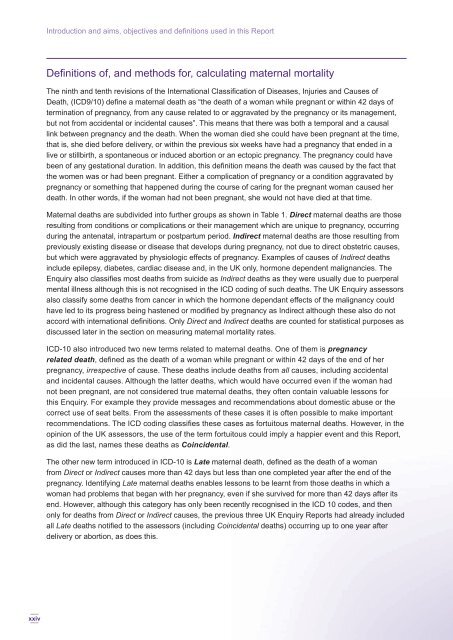Saving Mothers' Lives: - Public Health Agency for Northern Ireland
Saving Mothers' Lives: - Public Health Agency for Northern Ireland
Saving Mothers' Lives: - Public Health Agency for Northern Ireland
You also want an ePaper? Increase the reach of your titles
YUMPU automatically turns print PDFs into web optimized ePapers that Google loves.
xxiv<br />
Introduction and aims, objectives and defi nitions used in this Report<br />
Defi nitions of, and methods <strong>for</strong>, calculating maternal mortality<br />
The ninth and tenth revisions of the International Classifi cation of Diseases, Injuries and Causes of<br />
Death, (ICD9/10) defi ne a maternal death as “the death of a woman while pregnant or within 42 days of<br />
termination of pregnancy, from any cause related to or aggravated by the pregnancy or its management,<br />
but not from accidental or incidental causes”. This means that there was both a temporal and a causal<br />
link between pregnancy and the death. When the woman died she could have been pregnant at the time,<br />
that is, she died be<strong>for</strong>e delivery, or within the previous six weeks have had a pregnancy that ended in a<br />
live or stillbirth, a spontaneous or induced abortion or an ectopic pregnancy. The pregnancy could have<br />
been of any gestational duration. In addition, this defi nition means the death was caused by the fact that<br />
the women was or had been pregnant. Either a complication of pregnancy or a condition aggravated by<br />
pregnancy or something that happened during the course of caring <strong>for</strong> the pregnant woman caused her<br />
death. In other words, if the woman had not been pregnant, she would not have died at that time.<br />
Maternal deaths are subdivided into further groups as shown in Table 1. Direct maternal deaths are those<br />
resulting from conditions or complications or their management which are unique to pregnancy, occurring<br />
during the antenatal, intrapartum or postpartum period. Indirect maternal deaths are those resulting from<br />
previously existing disease or disease that develops during pregnancy, not due to direct obstetric causes,<br />
but which were aggravated by physiologic effects of pregnancy. Examples of causes of Indirect deaths<br />
include epilepsy, diabetes, cardiac disease and, in the UK only, hormone dependent malignancies. The<br />
Enquiry also classifi es most deaths from suicide as Indirect deaths as they were usually due to puerperal<br />
mental illness although this is not recognised in the ICD coding of such deaths. The UK Enquiry assessors<br />
also classify some deaths from cancer in which the hormone dependant effects of the malignancy could<br />
have led to its progress being hastened or modifi ed by pregnancy as Indirect although these also do not<br />
accord with international defi nitions. Only Direct and Indirect deaths are counted <strong>for</strong> statistical purposes as<br />
discussed later in the section on measuring maternal mortality rates.<br />
ICD-10 also introduced two new terms related to maternal deaths. One of them is pregnancy<br />
related death, defi ned as the death of a woman while pregnant or within 42 days of the end of her<br />
pregnancy, irrespective of cause. These deaths include deaths from all causes, including accidental<br />
and incidental causes. Although the latter deaths, which would have occurred even if the woman had<br />
not been pregnant, are not considered true maternal deaths, they often contain valuable lessons <strong>for</strong><br />
this Enquiry. For example they provide messages and recommendations about domestic abuse or the<br />
correct use of seat belts. From the assessments of these cases it is often possible to make important<br />
recommendations. The ICD coding classifi es these cases as <strong>for</strong>tuitous maternal deaths. However, in the<br />
opinion of the UK assessors, the use of the term <strong>for</strong>tuitous could imply a happier event and this Report,<br />
as did the last, names these deaths as Coincidental.<br />
The other new term introduced in ICD-10 is Late maternal death, defi ned as the death of a woman<br />
from Direct or Indirect causes more than 42 days but less than one completed year after the end of the<br />
pregnancy. Identifying Late maternal deaths enables lessons to be learnt from those deaths in which a<br />
woman had problems that began with her pregnancy, even if she survived <strong>for</strong> more than 42 days after its<br />
end. However, although this category has only been recently recognised in the ICD 10 codes, and then<br />
only <strong>for</strong> deaths from Direct or Indirect causes, the previous three UK Enquiry Reports had already included<br />
all Late deaths notifi ed to the assessors (including Coincidental deaths) occurring up to one year after<br />
delivery or abortion, as does this.



